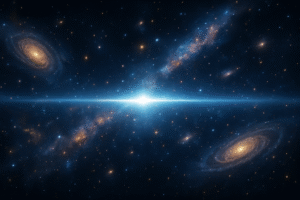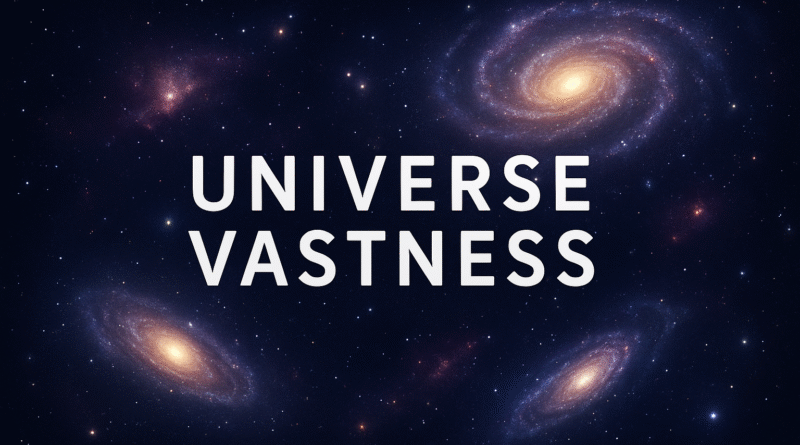Universe Vastness: 7 Astonishing Facts That Will Change How You See Space
Introduction — Universe Vastness in One Line
Universe Vastness is the single idea that quickly makes everything we know on Earth feel small. It’s the combination of enormous distances, mind-bending numbers, and structures far larger than our daily imagination. Because space is expanding and because light takes time to travel, the universe we can see is only a slice of what might exist. This post breaks the concept into ten deep, fact-based points — each explained simply and with real numbers or widely accepted scientific estimates — so you can actually feel the scale instead of just reading big words.
Fact 1 — Universe Vastness: From Earth to the Oort Cloud (Solar Neighborhood)
Universe Vastness starts at home: the gap between Earth and nearby space is enormous. Our planet’s average distance to the Sun is one astronomical unit (1 AU ≈ 149.6 million km). The Moon orbits at about 0.0026 AU (roughly 384,000 km),

which is close by cosmic standards.
Beyond Neptune (≈30 AU) lies the Kuiper Belt — where dwarf planets like Pluto orbit — stretching roughly from 30 to about 50 AU. Farther out, the hypothesized Oort Cloud may surround the solar system out to many tens of thousands of AU. Estimates commonly put the outer Oort Cloud out to around 100,000 AU — that’s on the order of 1–2 light-years. So, our solar system is not simply the eight planets and the Sun: it’s a tiny, protected region inside a much larger cloud of icy bodies that, in turn, sits inside the vastness of our galaxy.
Thinking in human terms helps: if the Sun were a basketball, Earth would be a pea several dozen meters away, Neptune would be a small speck much further, and the Oort Cloud would be a faint fog at huge distances from the court. Even that “fog” is still tiny compared with the distance to the nearest star or the size of the Milky Way. This immediate neighborhood is the first step in understanding Universe Vastness: even what we call “nearby” is staggeringly large.
Fact 2 — Universe Vastness: What a Light-Year Really Means
A key tool for measuring Universe Vastness is the light-year — the distance light travels in one year. Light moves at about 299,792 kilometers per second, so in a year it covers roughly 9.46 trillion kilometers (≈5.88 trillion miles). That makes a light-year perfect for expressing the colossal distances between stars and galaxies.
Examples put the number in context. Sunlight reaches Earth in about 8 minutes. The nearest star beyond the Sun, Proxima Centauri, sits about 4.24 light-years away: in other words, the light we see from that star left it more than four years ago. The Andromeda Galaxy, our nearest large galaxy neighbor, is roughly 2.5 million light-years away — the light we see today left Andromeda when Earth’s ancestors were early primates.
Because light takes time, looking farther out means looking back in time. A bright galaxy 10 billion light-years away shows us what that galaxy looked like 10 billion years ago. This simple idea — distance measured in time — is critical for understanding Universe Vastness. When astronomers map the sky, they are not only mapping space, they are mapping history.
Fact 3 — Universe Vastness: The Milky Way — Our Galactic Home
When we scale up, Universe Vastness quickly becomes humbling. The Milky Way is a barred spiral galaxy roughly 100,000 light-years across and contains on the order of 100–400 billion stars. Our Sun is just one of those. The galaxy’s structure includes a dense central bulge, sweeping spiral arms filled with stars and gas, and a faint halo that stretches far beyond the visible disk.
At the center sits a supermassive black hole, known as Sagittarius A*, weighing in at about four million times the mass of the Sun. Although that sounds enormous, Sagittarius A* is tiny compared to supermassive black holes in larger galaxies. The Milky Way is also just one member of a local group of galaxies, interacting gravitationally with neighbors like the Andromeda Galaxy and many dwarf galaxies.
Understanding the Milky Way’s size helps place us: the nearest stars are light-years away, and traveling even to the nearest star with today’s technology would take tens of thousands of years. That simple fact shows the first true layer of Universe Vastness — our galaxy is a vast ecosystem, and we are a tiny part of it.
Fact 4 — Universe Vastness: Galaxies — Types and How Many
Step beyond our galaxy and Universe Vastness multiplies. Galaxies come in three main categories — spiral, elliptical, and irregular — and range from dwarf galaxies with a few million stars to giant ellipticals with trillions. They assemble into systems, collide, merge, and evolve over billions of years.
Counting galaxies used to be a rough task. Deep surveys with the Hubble Space Telescope and other observatories revealed that the sky is full of faint galaxies, even in tiny patches. Estimates have changed as instruments improved: early counts suggested hundreds of billions, and later analyses revised the number to well over a trillion in the observable volume. Many astronomers now say there are at least hundreds of billions to a few trillion galaxies in the observable universe, though exact figures continue to be refined with better observations and models.
Each galaxy is itself a miniature universe of stars, planets, dust, and dark matter. When astronomers talk about Universe Vastness, they mean not only that there are many galaxies, but that each one hosts its own vast systems and histories.
Fact 5 — Universe Vastness: The Observable Universe — How Big and Why That Number Grows
The phrase Universe Vastness often refers to the observable universe — the portion of all space from which light has had time to reach us since the Big Bang. Because space has been expanding while light traveled, the observable universe forms a sphere with a radius of about 46.5 billion light-years, which makes the observable diameter roughly 93 billion light-years.
You might ask: the universe is 13.8 billion years old — why is the observable radius larger than 13.8 billion light-years? The answer is expansion: space itself has stretched while light was en route, so galaxies that emitted light long ago are now far farther away. As telescopes improve and methods for removing foreground noise get better, astronomers can see fainter and earlier galaxies — but the radius set by the speed of light and the universe’s expansion remains the fundamental horizon for direct observation.
Crucially, the observable limit is not necessarily the limit of the universe as a whole; it is only the part we can directly see. Universe Vastness goes far beyond observable boundaries, as later facts discuss.
Fact 6 — Universe Vastness: Expansion, Redshift, and Dark Energy
The idea of Universe Vastness is tightly linked to expansion. In the late 1920s, Edwin Hubble showed that distant galaxies are receding from us and that their recessional speed increases with distance — the basis of Hubble’s Law. Later, observations of distant exploding stars (Type Ia supernovae) in the late 1990s revealed that the expansion is accelerating rather than slowing. Scientists explained the acceleration by invoking dark energy, a mysterious component that behaves like a repulsive force on cosmic scales.
Modern cosmology estimates that dark energy contributes roughly 68% of the total energy density of the universe, with dark matter around 27% and ordinary, baryonic matter about 5%. The presence of dark energy means that distant galaxies will, over time, appear to recede beyond our observational reach. The practical result: Universe Vastness is not a static number — the area we can see and study changes over cosmic time because the universe itself is stretching.
Fact 7 — Universe Vastness: Looking Back in Time — Cosmic History in Light
One of the most powerful aspects of Universe Vastness is that distance equals time. When we look at very distant objects, we are seeing them as they were long ago. The earliest light we can directly observe is the cosmic microwave background (CMB), the afterglow of the Big Bang, released roughly 380,000 years after that event. The CMB is a snapshot of the universe when it became transparent.
Stars and galaxies formed later, with the first stars lighting up perhaps a few hundred million years after the Big Bang. By studying high-redshift galaxies — those whose light has been stretched to longer wavelengths by expansion — astronomers reconstruct how structure formed and evolved. So Universe Vastness is also a timeline: the farthest objects allow us to read the universe’s early chapters, and nearer objects show later eras. This time-depth is what makes astronomy a historical science, where deeper is older.
Conclusion — Why Universe Vastness Matters
Universe Vastness is not just a collection of big numbers. It changes how we think about life, time, and our place in reality. From the local reach of the Oort Cloud to the 93-billion-light-year breadth of the observable cosmos, from dark energy pushing galaxies apart to the cosmic web stitching matter together — the scale of everything forces us to ask better questions.
If you enjoyed this deep dive, check out related posts on my site:
-
Hubble Captures Interstellar Comet 3I/ATLAS in Stunning Detail
-
Asteroid Impact Probability: Shocking 1 in 155 Odds of a Strike in Your Lifetime

